Essay: Patient's Experience of Care, NMBA Standards, and Action Plan
VerifiedAdded on 2022/10/04
|8
|2169
|59
Essay
AI Summary
This essay delves into a reflective analysis of a 75-year-old patient's experience within a clinical setting. It examines both positive and negative aspects of care, including collaborative efforts and instances of negligence, such as prolonged pain and lack of fall prevention measures and e-health records literacy. The essay incorporates the patient's feelings and thoughts, and discusses the values and beliefs associated with their experience. It then assesses the care process against NMBA standards, identifying areas where the standards were either upheld or violated, and the impact on person-centered care. Finally, the essay concludes with an action plan proposing strategies to improve patient experience and quality of care, such as enhancing health literacy regarding electronic health records and implementing fall prevention measures.
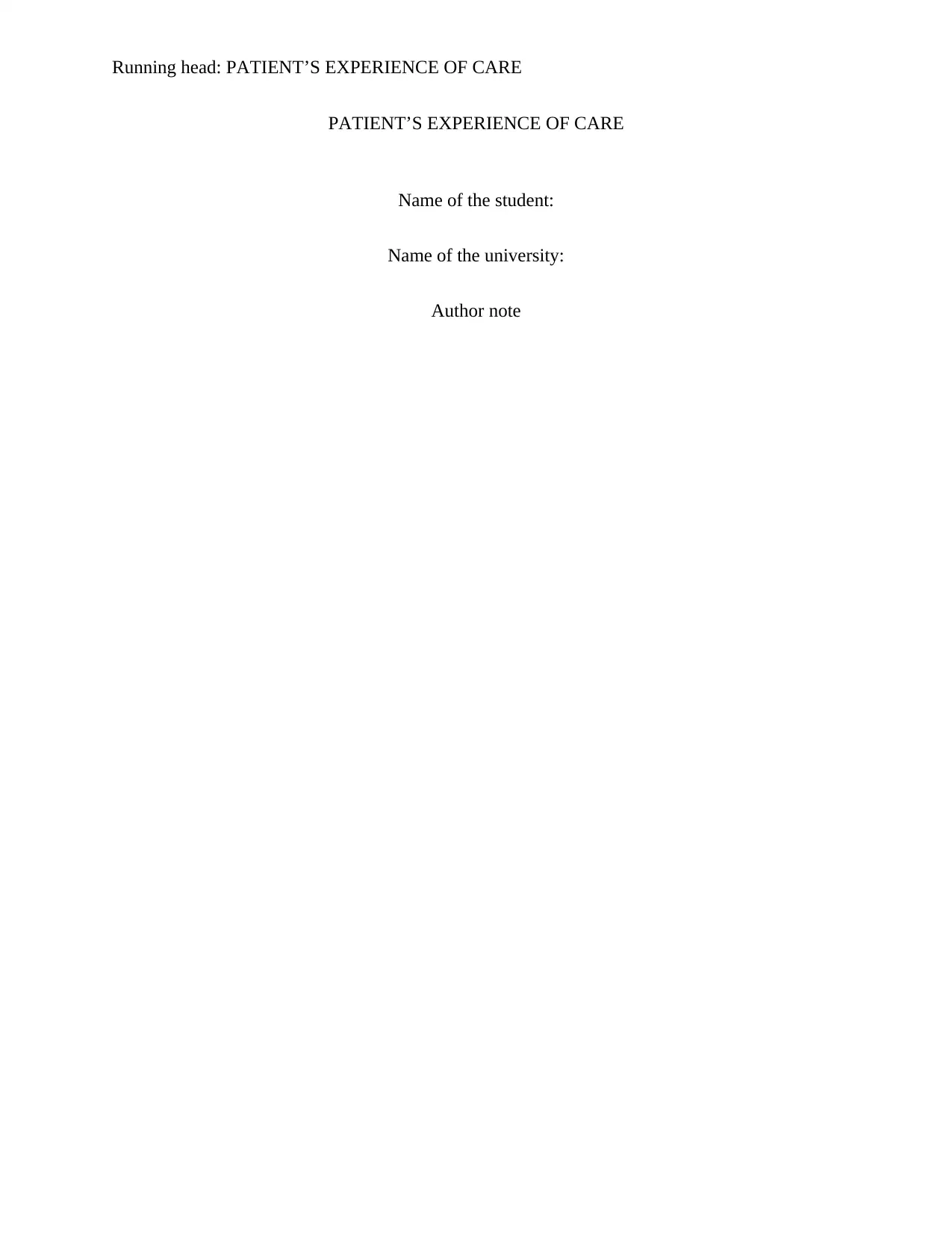
Running head: PATIENT’S EXPERIENCE OF CARE
PATIENT’S EXPERIENCE OF CARE
Name of the student:
Name of the university:
Author note
PATIENT’S EXPERIENCE OF CARE
Name of the student:
Name of the university:
Author note
Paraphrase This Document
Need a fresh take? Get an instant paraphrase of this document with our AI Paraphraser
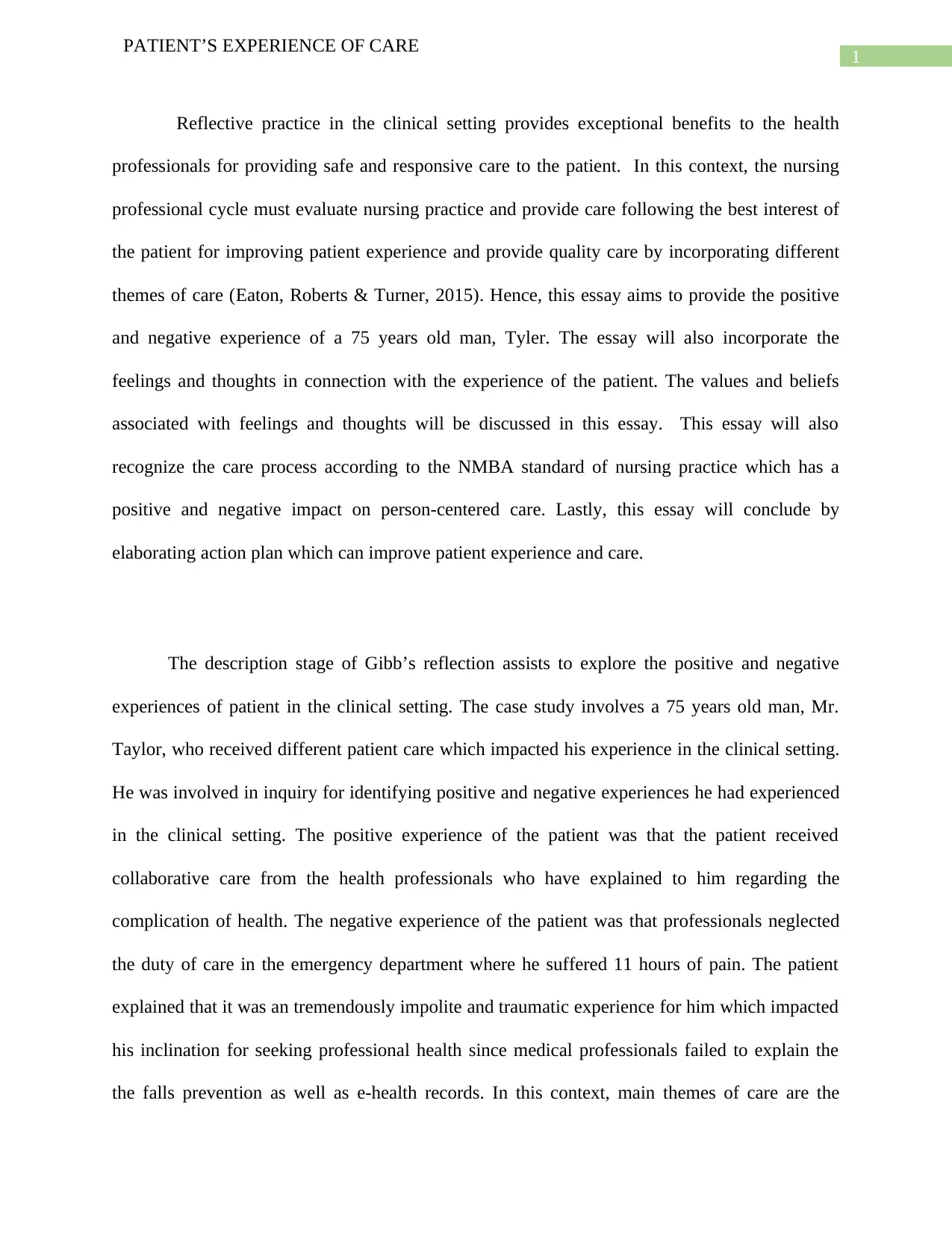
1
PATIENT’S EXPERIENCE OF CARE
Reflective practice in the clinical setting provides exceptional benefits to the health
professionals for providing safe and responsive care to the patient. In this context, the nursing
professional cycle must evaluate nursing practice and provide care following the best interest of
the patient for improving patient experience and provide quality care by incorporating different
themes of care (Eaton, Roberts & Turner, 2015). Hence, this essay aims to provide the positive
and negative experience of a 75 years old man, Tyler. The essay will also incorporate the
feelings and thoughts in connection with the experience of the patient. The values and beliefs
associated with feelings and thoughts will be discussed in this essay. This essay will also
recognize the care process according to the NMBA standard of nursing practice which has a
positive and negative impact on person-centered care. Lastly, this essay will conclude by
elaborating action plan which can improve patient experience and care.
The description stage of Gibb’s reflection assists to explore the positive and negative
experiences of patient in the clinical setting. The case study involves a 75 years old man, Mr.
Taylor, who received different patient care which impacted his experience in the clinical setting.
He was involved in inquiry for identifying positive and negative experiences he had experienced
in the clinical setting. The positive experience of the patient was that the patient received
collaborative care from the health professionals who have explained to him regarding the
complication of health. The negative experience of the patient was that professionals neglected
the duty of care in the emergency department where he suffered 11 hours of pain. The patient
explained that it was an tremendously impolite and traumatic experience for him which impacted
his inclination for seeking professional health since medical professionals failed to explain the
the falls prevention as well as e-health records. In this context, main themes of care are the
PATIENT’S EXPERIENCE OF CARE
Reflective practice in the clinical setting provides exceptional benefits to the health
professionals for providing safe and responsive care to the patient. In this context, the nursing
professional cycle must evaluate nursing practice and provide care following the best interest of
the patient for improving patient experience and provide quality care by incorporating different
themes of care (Eaton, Roberts & Turner, 2015). Hence, this essay aims to provide the positive
and negative experience of a 75 years old man, Tyler. The essay will also incorporate the
feelings and thoughts in connection with the experience of the patient. The values and beliefs
associated with feelings and thoughts will be discussed in this essay. This essay will also
recognize the care process according to the NMBA standard of nursing practice which has a
positive and negative impact on person-centered care. Lastly, this essay will conclude by
elaborating action plan which can improve patient experience and care.
The description stage of Gibb’s reflection assists to explore the positive and negative
experiences of patient in the clinical setting. The case study involves a 75 years old man, Mr.
Taylor, who received different patient care which impacted his experience in the clinical setting.
He was involved in inquiry for identifying positive and negative experiences he had experienced
in the clinical setting. The positive experience of the patient was that the patient received
collaborative care from the health professionals who have explained to him regarding the
complication of health. The negative experience of the patient was that professionals neglected
the duty of care in the emergency department where he suffered 11 hours of pain. The patient
explained that it was an tremendously impolite and traumatic experience for him which impacted
his inclination for seeking professional health since medical professionals failed to explain the
the falls prevention as well as e-health records. In this context, main themes of care are the
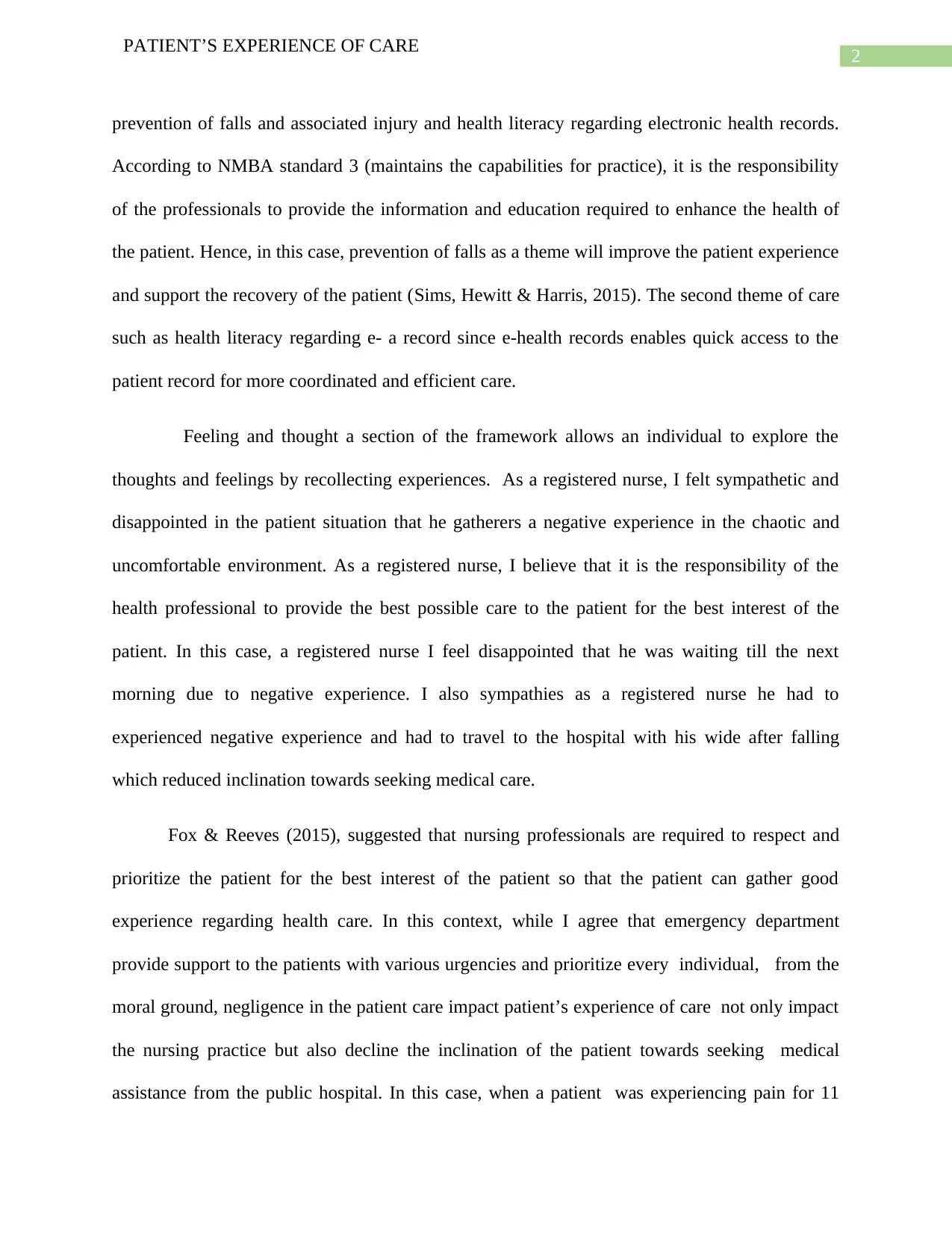
2
PATIENT’S EXPERIENCE OF CARE
prevention of falls and associated injury and health literacy regarding electronic health records.
According to NMBA standard 3 (maintains the capabilities for practice), it is the responsibility
of the professionals to provide the information and education required to enhance the health of
the patient. Hence, in this case, prevention of falls as a theme will improve the patient experience
and support the recovery of the patient (Sims, Hewitt & Harris, 2015). The second theme of care
such as health literacy regarding e- a record since e-health records enables quick access to the
patient record for more coordinated and efficient care.
Feeling and thought a section of the framework allows an individual to explore the
thoughts and feelings by recollecting experiences. As a registered nurse, I felt sympathetic and
disappointed in the patient situation that he gatherers a negative experience in the chaotic and
uncomfortable environment. As a registered nurse, I believe that it is the responsibility of the
health professional to provide the best possible care to the patient for the best interest of the
patient. In this case, a registered nurse I feel disappointed that he was waiting till the next
morning due to negative experience. I also sympathies as a registered nurse he had to
experienced negative experience and had to travel to the hospital with his wide after falling
which reduced inclination towards seeking medical care.
Fox & Reeves (2015), suggested that nursing professionals are required to respect and
prioritize the patient for the best interest of the patient so that the patient can gather good
experience regarding health care. In this context, while I agree that emergency department
provide support to the patients with various urgencies and prioritize every individual, from the
moral ground, negligence in the patient care impact patient’s experience of care not only impact
the nursing practice but also decline the inclination of the patient towards seeking medical
assistance from the public hospital. In this case, when a patient was experiencing pain for 11
PATIENT’S EXPERIENCE OF CARE
prevention of falls and associated injury and health literacy regarding electronic health records.
According to NMBA standard 3 (maintains the capabilities for practice), it is the responsibility
of the professionals to provide the information and education required to enhance the health of
the patient. Hence, in this case, prevention of falls as a theme will improve the patient experience
and support the recovery of the patient (Sims, Hewitt & Harris, 2015). The second theme of care
such as health literacy regarding e- a record since e-health records enables quick access to the
patient record for more coordinated and efficient care.
Feeling and thought a section of the framework allows an individual to explore the
thoughts and feelings by recollecting experiences. As a registered nurse, I felt sympathetic and
disappointed in the patient situation that he gatherers a negative experience in the chaotic and
uncomfortable environment. As a registered nurse, I believe that it is the responsibility of the
health professional to provide the best possible care to the patient for the best interest of the
patient. In this case, a registered nurse I feel disappointed that he was waiting till the next
morning due to negative experience. I also sympathies as a registered nurse he had to
experienced negative experience and had to travel to the hospital with his wide after falling
which reduced inclination towards seeking medical care.
Fox & Reeves (2015), suggested that nursing professionals are required to respect and
prioritize the patient for the best interest of the patient so that the patient can gather good
experience regarding health care. In this context, while I agree that emergency department
provide support to the patients with various urgencies and prioritize every individual, from the
moral ground, negligence in the patient care impact patient’s experience of care not only impact
the nursing practice but also decline the inclination of the patient towards seeking medical
assistance from the public hospital. In this case, when a patient was experiencing pain for 11
⊘ This is a preview!⊘
Do you want full access?
Subscribe today to unlock all pages.

Trusted by 1+ million students worldwide
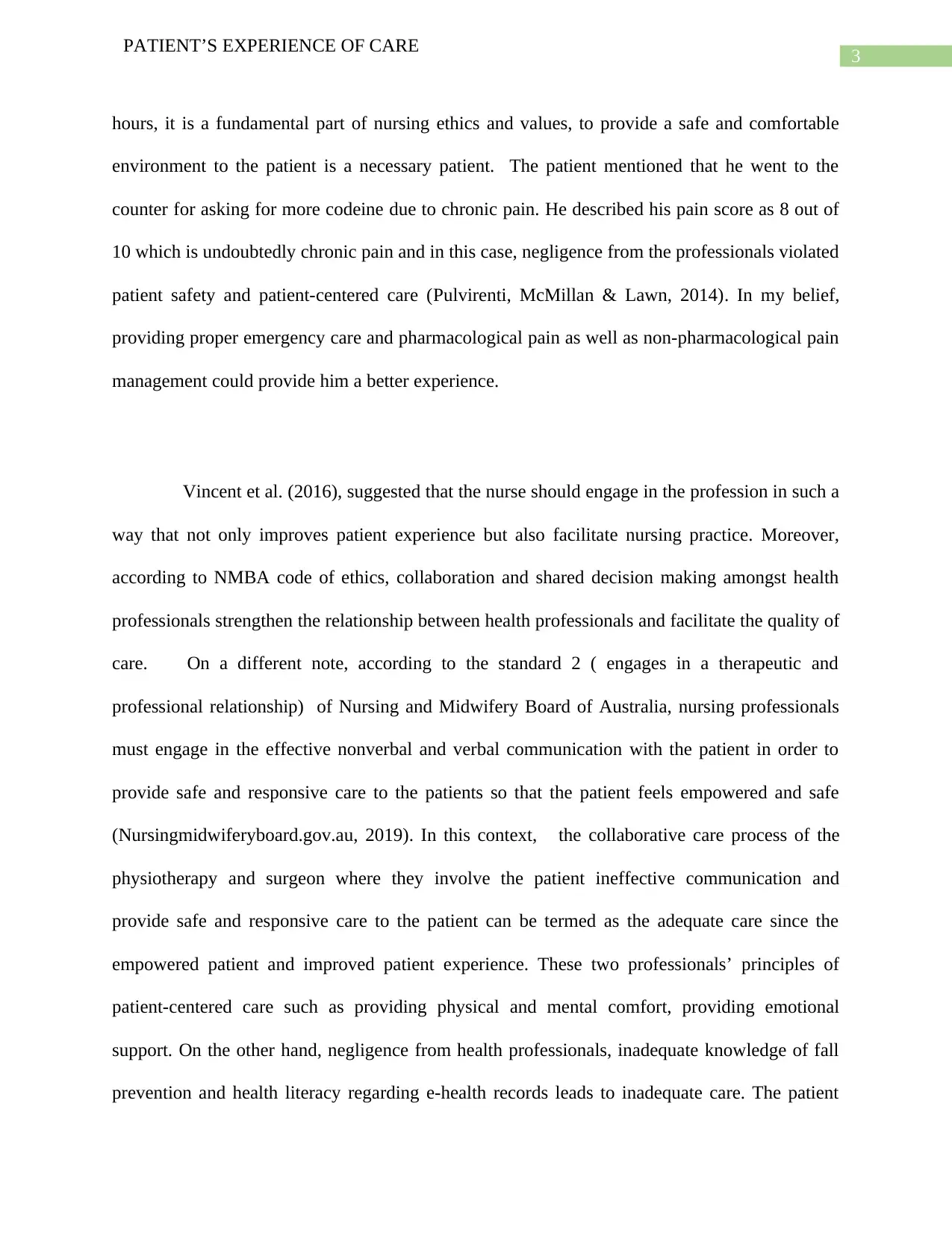
3
PATIENT’S EXPERIENCE OF CARE
hours, it is a fundamental part of nursing ethics and values, to provide a safe and comfortable
environment to the patient is a necessary patient. The patient mentioned that he went to the
counter for asking for more codeine due to chronic pain. He described his pain score as 8 out of
10 which is undoubtedly chronic pain and in this case, negligence from the professionals violated
patient safety and patient-centered care (Pulvirenti, McMillan & Lawn, 2014). In my belief,
providing proper emergency care and pharmacological pain as well as non-pharmacological pain
management could provide him a better experience.
Vincent et al. (2016), suggested that the nurse should engage in the profession in such a
way that not only improves patient experience but also facilitate nursing practice. Moreover,
according to NMBA code of ethics, collaboration and shared decision making amongst health
professionals strengthen the relationship between health professionals and facilitate the quality of
care. On a different note, according to the standard 2 ( engages in a therapeutic and
professional relationship) of Nursing and Midwifery Board of Australia, nursing professionals
must engage in the effective nonverbal and verbal communication with the patient in order to
provide safe and responsive care to the patients so that the patient feels empowered and safe
(Nursingmidwiferyboard.gov.au, 2019). In this context, the collaborative care process of the
physiotherapy and surgeon where they involve the patient ineffective communication and
provide safe and responsive care to the patient can be termed as the adequate care since the
empowered patient and improved patient experience. These two professionals’ principles of
patient-centered care such as providing physical and mental comfort, providing emotional
support. On the other hand, negligence from health professionals, inadequate knowledge of fall
prevention and health literacy regarding e-health records leads to inadequate care. The patient
PATIENT’S EXPERIENCE OF CARE
hours, it is a fundamental part of nursing ethics and values, to provide a safe and comfortable
environment to the patient is a necessary patient. The patient mentioned that he went to the
counter for asking for more codeine due to chronic pain. He described his pain score as 8 out of
10 which is undoubtedly chronic pain and in this case, negligence from the professionals violated
patient safety and patient-centered care (Pulvirenti, McMillan & Lawn, 2014). In my belief,
providing proper emergency care and pharmacological pain as well as non-pharmacological pain
management could provide him a better experience.
Vincent et al. (2016), suggested that the nurse should engage in the profession in such a
way that not only improves patient experience but also facilitate nursing practice. Moreover,
according to NMBA code of ethics, collaboration and shared decision making amongst health
professionals strengthen the relationship between health professionals and facilitate the quality of
care. On a different note, according to the standard 2 ( engages in a therapeutic and
professional relationship) of Nursing and Midwifery Board of Australia, nursing professionals
must engage in the effective nonverbal and verbal communication with the patient in order to
provide safe and responsive care to the patients so that the patient feels empowered and safe
(Nursingmidwiferyboard.gov.au, 2019). In this context, the collaborative care process of the
physiotherapy and surgeon where they involve the patient ineffective communication and
provide safe and responsive care to the patient can be termed as the adequate care since the
empowered patient and improved patient experience. These two professionals’ principles of
patient-centered care such as providing physical and mental comfort, providing emotional
support. On the other hand, negligence from health professionals, inadequate knowledge of fall
prevention and health literacy regarding e-health records leads to inadequate care. The patient
Paraphrase This Document
Need a fresh take? Get an instant paraphrase of this document with our AI Paraphraser
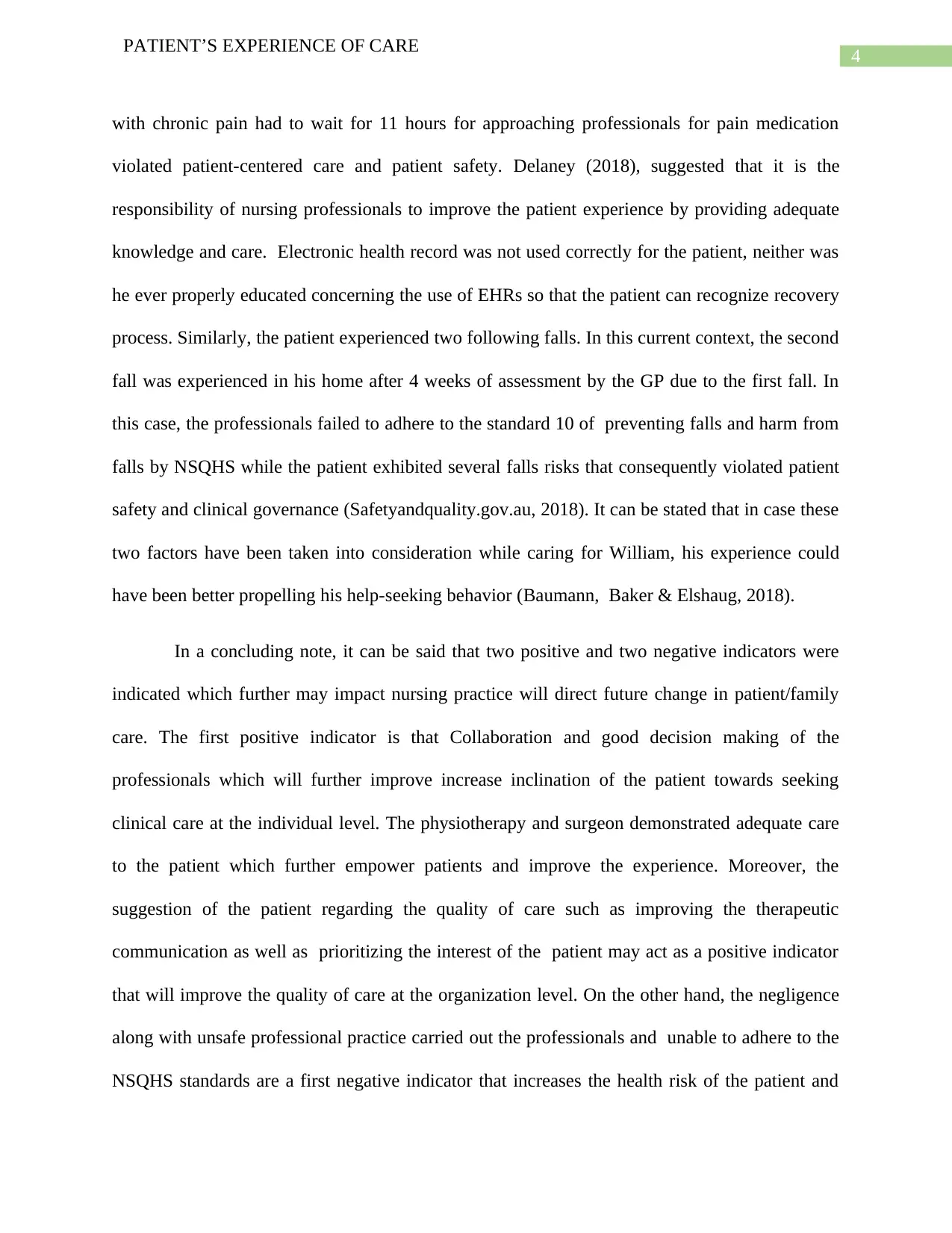
4
PATIENT’S EXPERIENCE OF CARE
with chronic pain had to wait for 11 hours for approaching professionals for pain medication
violated patient-centered care and patient safety. Delaney (2018), suggested that it is the
responsibility of nursing professionals to improve the patient experience by providing adequate
knowledge and care. Electronic health record was not used correctly for the patient, neither was
he ever properly educated concerning the use of EHRs so that the patient can recognize recovery
process. Similarly, the patient experienced two following falls. In this current context, the second
fall was experienced in his home after 4 weeks of assessment by the GP due to the first fall. In
this case, the professionals failed to adhere to the standard 10 of preventing falls and harm from
falls by NSQHS while the patient exhibited several falls risks that consequently violated patient
safety and clinical governance (Safetyandquality.gov.au, 2018). It can be stated that in case these
two factors have been taken into consideration while caring for William, his experience could
have been better propelling his help-seeking behavior (Baumann, Baker & Elshaug, 2018).
In a concluding note, it can be said that two positive and two negative indicators were
indicated which further may impact nursing practice will direct future change in patient/family
care. The first positive indicator is that Collaboration and good decision making of the
professionals which will further improve increase inclination of the patient towards seeking
clinical care at the individual level. The physiotherapy and surgeon demonstrated adequate care
to the patient which further empower patients and improve the experience. Moreover, the
suggestion of the patient regarding the quality of care such as improving the therapeutic
communication as well as prioritizing the interest of the patient may act as a positive indicator
that will improve the quality of care at the organization level. On the other hand, the negligence
along with unsafe professional practice carried out the professionals and unable to adhere to the
NSQHS standards are a first negative indicator that increases the health risk of the patient and
PATIENT’S EXPERIENCE OF CARE
with chronic pain had to wait for 11 hours for approaching professionals for pain medication
violated patient-centered care and patient safety. Delaney (2018), suggested that it is the
responsibility of nursing professionals to improve the patient experience by providing adequate
knowledge and care. Electronic health record was not used correctly for the patient, neither was
he ever properly educated concerning the use of EHRs so that the patient can recognize recovery
process. Similarly, the patient experienced two following falls. In this current context, the second
fall was experienced in his home after 4 weeks of assessment by the GP due to the first fall. In
this case, the professionals failed to adhere to the standard 10 of preventing falls and harm from
falls by NSQHS while the patient exhibited several falls risks that consequently violated patient
safety and clinical governance (Safetyandquality.gov.au, 2018). It can be stated that in case these
two factors have been taken into consideration while caring for William, his experience could
have been better propelling his help-seeking behavior (Baumann, Baker & Elshaug, 2018).
In a concluding note, it can be said that two positive and two negative indicators were
indicated which further may impact nursing practice will direct future change in patient/family
care. The first positive indicator is that Collaboration and good decision making of the
professionals which will further improve increase inclination of the patient towards seeking
clinical care at the individual level. The physiotherapy and surgeon demonstrated adequate care
to the patient which further empower patients and improve the experience. Moreover, the
suggestion of the patient regarding the quality of care such as improving the therapeutic
communication as well as prioritizing the interest of the patient may act as a positive indicator
that will improve the quality of care at the organization level. On the other hand, the negligence
along with unsafe professional practice carried out the professionals and unable to adhere to the
NSQHS standards are a first negative indicator that increases the health risk of the patient and
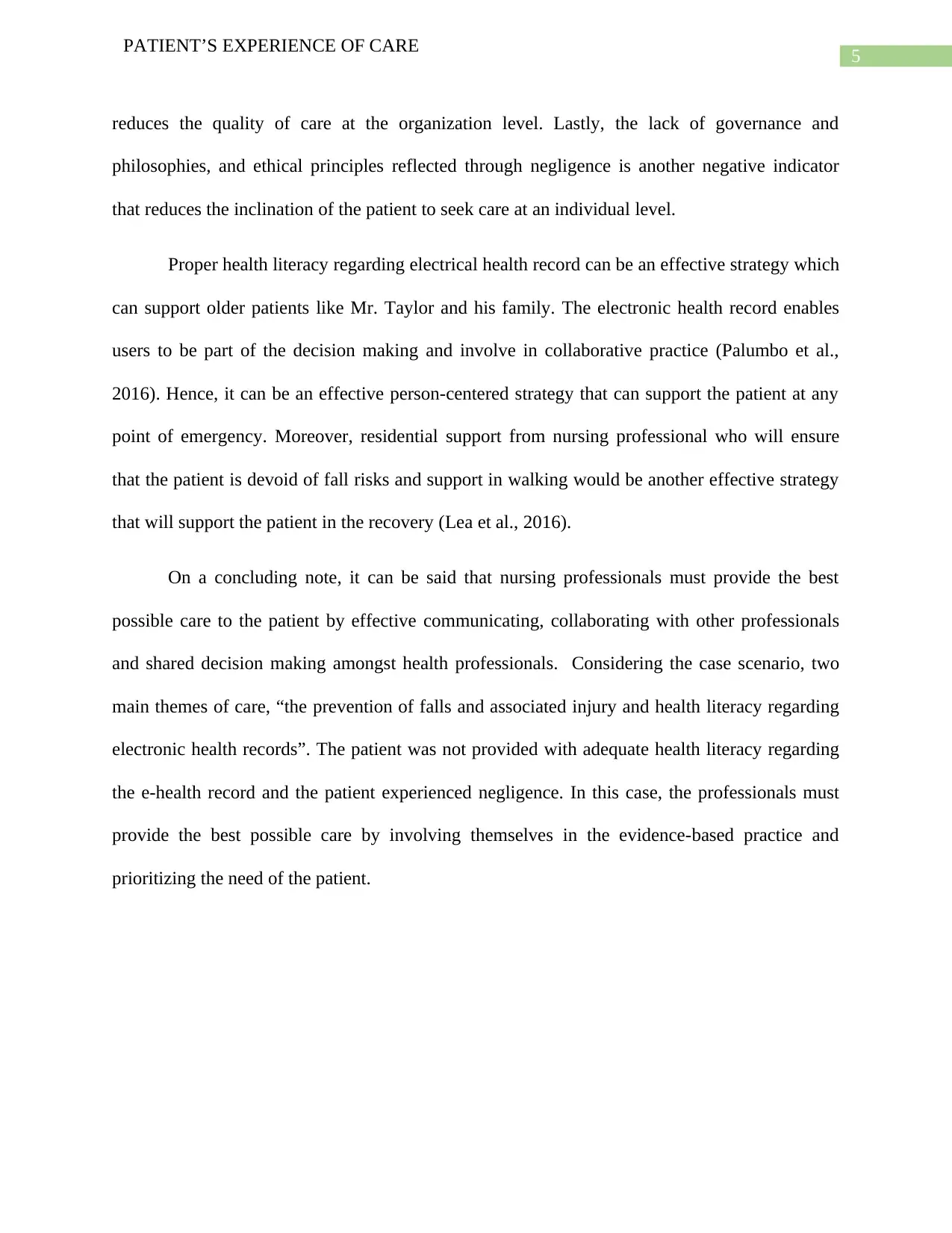
5
PATIENT’S EXPERIENCE OF CARE
reduces the quality of care at the organization level. Lastly, the lack of governance and
philosophies, and ethical principles reflected through negligence is another negative indicator
that reduces the inclination of the patient to seek care at an individual level.
Proper health literacy regarding electrical health record can be an effective strategy which
can support older patients like Mr. Taylor and his family. The electronic health record enables
users to be part of the decision making and involve in collaborative practice (Palumbo et al.,
2016). Hence, it can be an effective person-centered strategy that can support the patient at any
point of emergency. Moreover, residential support from nursing professional who will ensure
that the patient is devoid of fall risks and support in walking would be another effective strategy
that will support the patient in the recovery (Lea et al., 2016).
On a concluding note, it can be said that nursing professionals must provide the best
possible care to the patient by effective communicating, collaborating with other professionals
and shared decision making amongst health professionals. Considering the case scenario, two
main themes of care, “the prevention of falls and associated injury and health literacy regarding
electronic health records”. The patient was not provided with adequate health literacy regarding
the e-health record and the patient experienced negligence. In this case, the professionals must
provide the best possible care by involving themselves in the evidence-based practice and
prioritizing the need of the patient.
PATIENT’S EXPERIENCE OF CARE
reduces the quality of care at the organization level. Lastly, the lack of governance and
philosophies, and ethical principles reflected through negligence is another negative indicator
that reduces the inclination of the patient to seek care at an individual level.
Proper health literacy regarding electrical health record can be an effective strategy which
can support older patients like Mr. Taylor and his family. The electronic health record enables
users to be part of the decision making and involve in collaborative practice (Palumbo et al.,
2016). Hence, it can be an effective person-centered strategy that can support the patient at any
point of emergency. Moreover, residential support from nursing professional who will ensure
that the patient is devoid of fall risks and support in walking would be another effective strategy
that will support the patient in the recovery (Lea et al., 2016).
On a concluding note, it can be said that nursing professionals must provide the best
possible care to the patient by effective communicating, collaborating with other professionals
and shared decision making amongst health professionals. Considering the case scenario, two
main themes of care, “the prevention of falls and associated injury and health literacy regarding
electronic health records”. The patient was not provided with adequate health literacy regarding
the e-health record and the patient experienced negligence. In this case, the professionals must
provide the best possible care by involving themselves in the evidence-based practice and
prioritizing the need of the patient.
⊘ This is a preview!⊘
Do you want full access?
Subscribe today to unlock all pages.

Trusted by 1+ million students worldwide
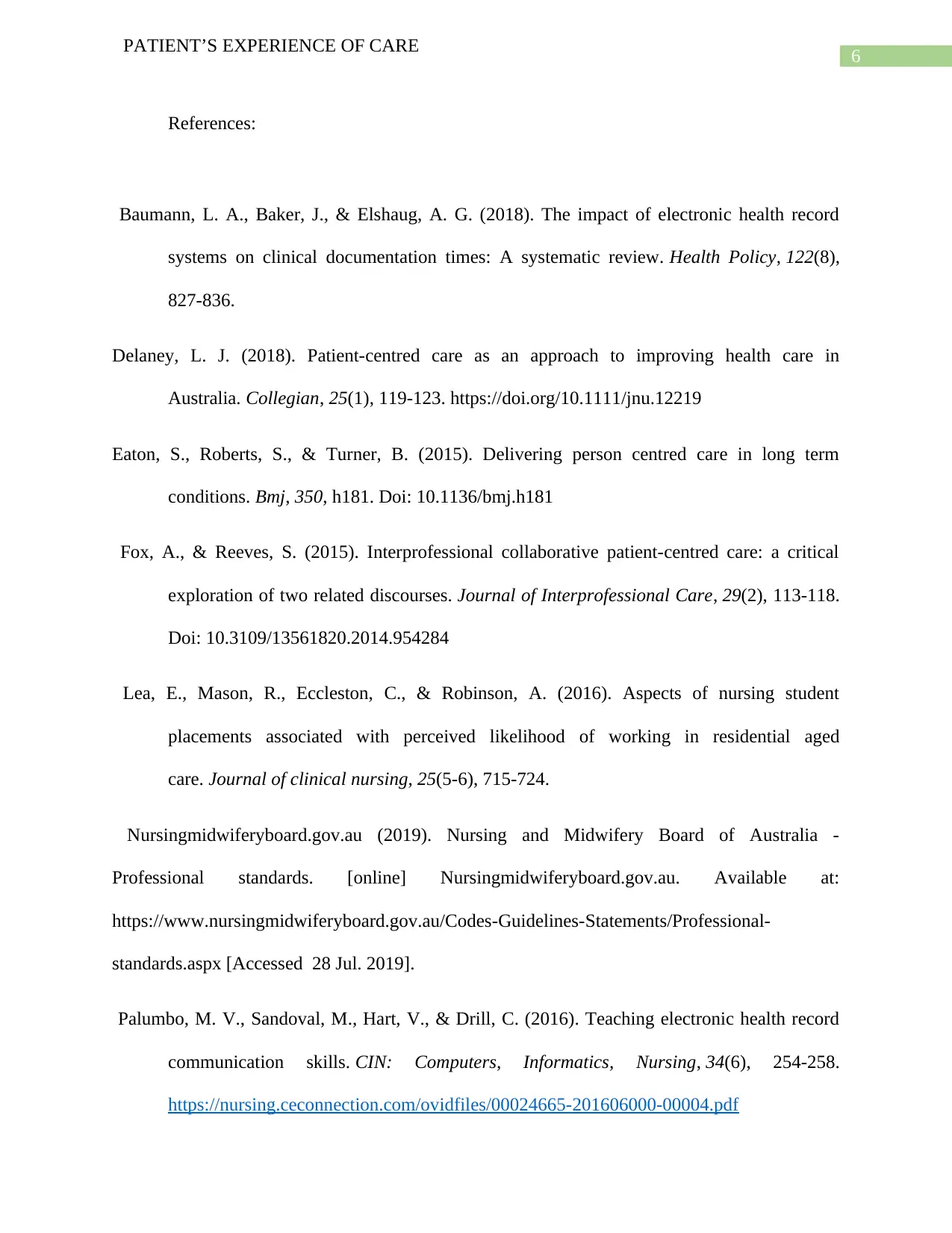
6
PATIENT’S EXPERIENCE OF CARE
References:
Baumann, L. A., Baker, J., & Elshaug, A. G. (2018). The impact of electronic health record
systems on clinical documentation times: A systematic review. Health Policy, 122(8),
827-836.
Delaney, L. J. (2018). Patient-centred care as an approach to improving health care in
Australia. Collegian, 25(1), 119-123. https://doi.org/10.1111/jnu.12219
Eaton, S., Roberts, S., & Turner, B. (2015). Delivering person centred care in long term
conditions. Bmj, 350, h181. Doi: 10.1136/bmj.h181
Fox, A., & Reeves, S. (2015). Interprofessional collaborative patient-centred care: a critical
exploration of two related discourses. Journal of Interprofessional Care, 29(2), 113-118.
Doi: 10.3109/13561820.2014.954284
Lea, E., Mason, R., Eccleston, C., & Robinson, A. (2016). Aspects of nursing student
placements associated with perceived likelihood of working in residential aged
care. Journal of clinical nursing, 25(5-6), 715-724.
Nursingmidwiferyboard.gov.au (2019). Nursing and Midwifery Board of Australia -
Professional standards. [online] Nursingmidwiferyboard.gov.au. Available at:
https://www.nursingmidwiferyboard.gov.au/Codes-Guidelines-Statements/Professional-
standards.aspx [Accessed 28 Jul. 2019].
Palumbo, M. V., Sandoval, M., Hart, V., & Drill, C. (2016). Teaching electronic health record
communication skills. CIN: Computers, Informatics, Nursing, 34(6), 254-258.
https://nursing.ceconnection.com/ovidfiles/00024665-201606000-00004.pdf
PATIENT’S EXPERIENCE OF CARE
References:
Baumann, L. A., Baker, J., & Elshaug, A. G. (2018). The impact of electronic health record
systems on clinical documentation times: A systematic review. Health Policy, 122(8),
827-836.
Delaney, L. J. (2018). Patient-centred care as an approach to improving health care in
Australia. Collegian, 25(1), 119-123. https://doi.org/10.1111/jnu.12219
Eaton, S., Roberts, S., & Turner, B. (2015). Delivering person centred care in long term
conditions. Bmj, 350, h181. Doi: 10.1136/bmj.h181
Fox, A., & Reeves, S. (2015). Interprofessional collaborative patient-centred care: a critical
exploration of two related discourses. Journal of Interprofessional Care, 29(2), 113-118.
Doi: 10.3109/13561820.2014.954284
Lea, E., Mason, R., Eccleston, C., & Robinson, A. (2016). Aspects of nursing student
placements associated with perceived likelihood of working in residential aged
care. Journal of clinical nursing, 25(5-6), 715-724.
Nursingmidwiferyboard.gov.au (2019). Nursing and Midwifery Board of Australia -
Professional standards. [online] Nursingmidwiferyboard.gov.au. Available at:
https://www.nursingmidwiferyboard.gov.au/Codes-Guidelines-Statements/Professional-
standards.aspx [Accessed 28 Jul. 2019].
Palumbo, M. V., Sandoval, M., Hart, V., & Drill, C. (2016). Teaching electronic health record
communication skills. CIN: Computers, Informatics, Nursing, 34(6), 254-258.
https://nursing.ceconnection.com/ovidfiles/00024665-201606000-00004.pdf
Paraphrase This Document
Need a fresh take? Get an instant paraphrase of this document with our AI Paraphraser
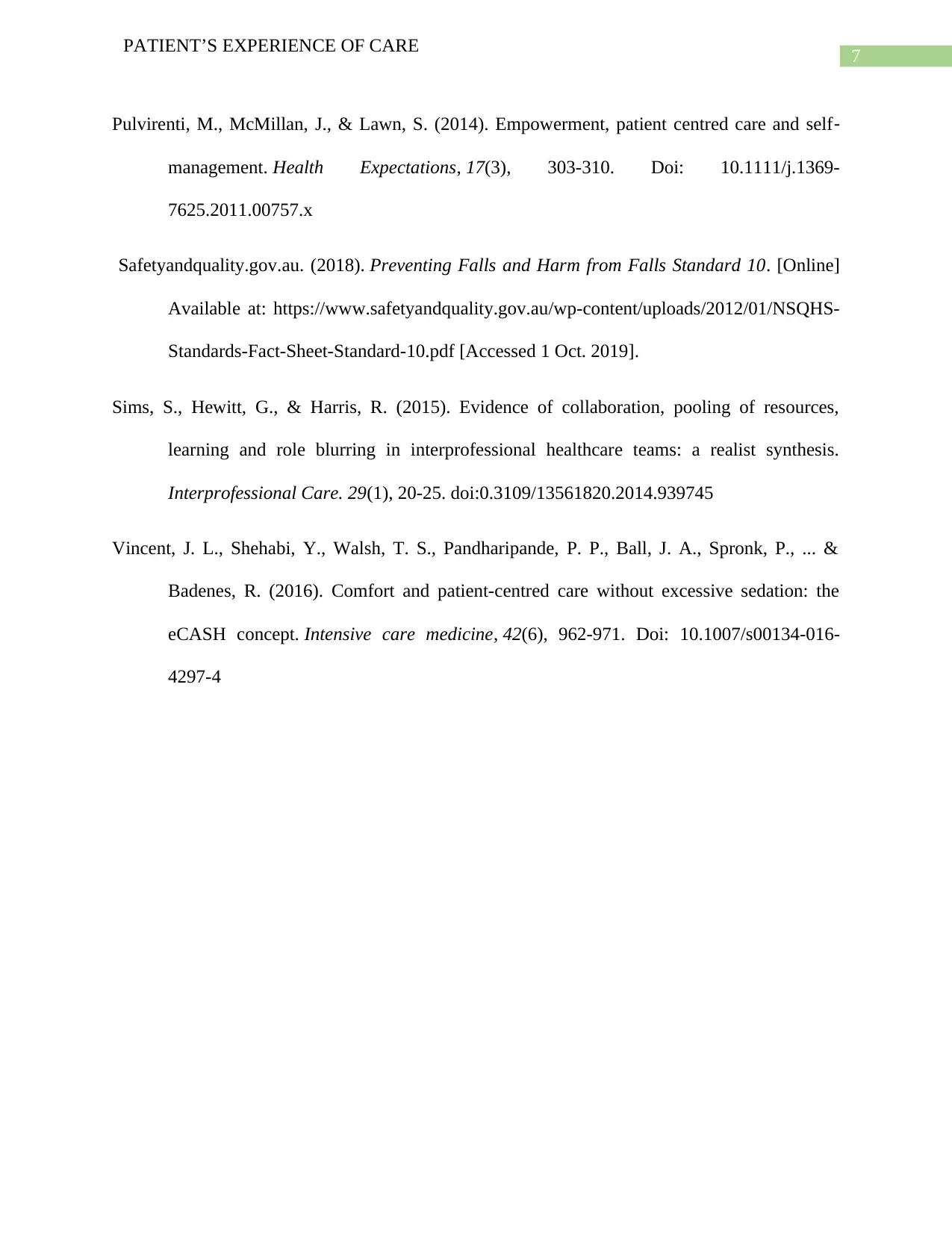
7
PATIENT’S EXPERIENCE OF CARE
Pulvirenti, M., McMillan, J., & Lawn, S. (2014). Empowerment, patient centred care and self‐
management. Health Expectations, 17(3), 303-310. Doi: 10.1111/j.1369-
7625.2011.00757.x
Safetyandquality.gov.au. (2018). Preventing Falls and Harm from Falls Standard 10. [Online]
Available at: https://www.safetyandquality.gov.au/wp-content/uploads/2012/01/NSQHS-
Standards-Fact-Sheet-Standard-10.pdf [Accessed 1 Oct. 2019].
Sims, S., Hewitt, G., & Harris, R. (2015). Evidence of collaboration, pooling of resources,
learning and role blurring in interprofessional healthcare teams: a realist synthesis.
Interprofessional Care. 29(1), 20-25. doi:0.3109/13561820.2014.939745
Vincent, J. L., Shehabi, Y., Walsh, T. S., Pandharipande, P. P., Ball, J. A., Spronk, P., ... &
Badenes, R. (2016). Comfort and patient-centred care without excessive sedation: the
eCASH concept. Intensive care medicine, 42(6), 962-971. Doi: 10.1007/s00134-016-
4297-4
PATIENT’S EXPERIENCE OF CARE
Pulvirenti, M., McMillan, J., & Lawn, S. (2014). Empowerment, patient centred care and self‐
management. Health Expectations, 17(3), 303-310. Doi: 10.1111/j.1369-
7625.2011.00757.x
Safetyandquality.gov.au. (2018). Preventing Falls and Harm from Falls Standard 10. [Online]
Available at: https://www.safetyandquality.gov.au/wp-content/uploads/2012/01/NSQHS-
Standards-Fact-Sheet-Standard-10.pdf [Accessed 1 Oct. 2019].
Sims, S., Hewitt, G., & Harris, R. (2015). Evidence of collaboration, pooling of resources,
learning and role blurring in interprofessional healthcare teams: a realist synthesis.
Interprofessional Care. 29(1), 20-25. doi:0.3109/13561820.2014.939745
Vincent, J. L., Shehabi, Y., Walsh, T. S., Pandharipande, P. P., Ball, J. A., Spronk, P., ... &
Badenes, R. (2016). Comfort and patient-centred care without excessive sedation: the
eCASH concept. Intensive care medicine, 42(6), 962-971. Doi: 10.1007/s00134-016-
4297-4
1 out of 8
Related Documents
Your All-in-One AI-Powered Toolkit for Academic Success.
+13062052269
info@desklib.com
Available 24*7 on WhatsApp / Email
![[object Object]](/_next/static/media/star-bottom.7253800d.svg)
Unlock your academic potential
Copyright © 2020–2025 A2Z Services. All Rights Reserved. Developed and managed by ZUCOL.




